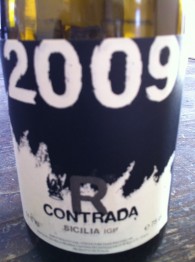Touring Sicily on wine and food exploration turned into an adventure – as I expected.
There were grapes to discover. They were relatively new to an enduring Aussie palate but oh so ancient to the Sicilians in the know.
And the number of vineyard investments, many non-Sicilian, are growing steadily as time passes is a sign of more prosperity to come.
A quick look at the vineyard landscape would not suggest an inviting environment for cultivating its natural red inhabitants, mainly nerello mascalese and its lesser cousin nerello capuccio.
Over eons the volcano Etna above has showered the countryside with both eruptive lava, and sometimes daily doses of ash powder.
The vine environment looks more lunar than viticultural – uninviting, cactus-strewn, rugged, craggy laval monuments sited between, amongst and encircling some vineyard sites. Lava rock is the fence of choice.
This has not denied Etnan development in the least; the lava weathers well, the soils are limiting but presumably sufficiently fertile. The local water is certainly mineralised!
Viticulture is not new here, but is undergoing rejuvenation of the same varieties which have existed for over a century, or more, and probably since antiquity, given the past Roman and Greek influences.
The best influence is the modern thinking: forget the crazy DOC/DOCG system founded by traditionalists and therefore held to be inflexible, and labelling as IGT (Sicilia IGT) indicates contemporary, real-world Sicilian wine (the variety is revealed).
So the process of recognising “crus” or the Sicilian equivalent as “contrade” around the Etna DOC is accelerating nicely, with a greater recognition also according to elevation, starting at 600 m, extending to 1000 m.
Obviously there is greater viticultural risk ripening nerellos at 1000 m, protracted harvest dates, slow times to physiological ripeness, while the few examples I tasted demonstrate greater aromatic character than their equivalents grown at lower heights.
Passopisciaro’s tasting host Letizia Patane presented three 2010 nerello mascalese from differing contrade (there are four):
Rampante of 2 ha (1000 m), Sciaranouva, meaning new lava flow site, these vines are 50 years going older, (800 m) and Porcaria, meaning ugly thing.
These wines are sold as single vineyard contrade.
Ramparte showed a lot of flowers, roses, small floral notes, attractive cool-grown influence, sweet in the mouth (the only one to do so), long in fruitiness, distinctive acid and tannin-acid balance; Sciaranouva showed funk (natural yeast effect), some oak aromas, volumes of nose, then black fruits palate, fine and long; Porcaria showed red fruits on nose, black fruits on palate, warming alcohol, yet retains its elegance.
What is the taste anatomy of nerello mascalese. Not a heavily coloured varietal wine, in sync with pinot nero or nebbiolo there. The nose aromatics range from red cherry, black cherry, wild yeast effects, tobacco, earth, spearmint and a range of herbal nuances.
Palate: never full bodied, closer to light-bodied, more textured with a length of flavour which needs to be supported by drying tannin and rising acidity (nebbiolo similarities), oak is subliminal and hardly detectable; minerality on finish is a given. Savouriness.
Sensations in this varietal rise when tasted while eating; in drinking solo the flavours are present but the tannins will often appear unbalanced.
So here is a process for enjoying Etna IGT varietals.
Peter Scudamore-Smith is a Brisbane-based Master of Wine, winemaker and educator www.uncorkedandcultivated.com.au





 Top Italian reds: are the Tuscans prevailing or is the pre-eminence of Piedmontese nebbiolo be set to prevail?
Top Italian reds: are the Tuscans prevailing or is the pre-eminence of Piedmontese nebbiolo be set to prevail?










